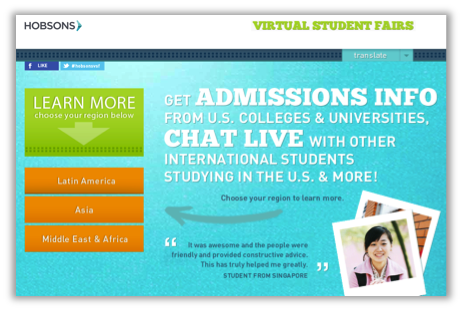11. Virtual college fairs
You are reading an excerpt from our e-book "88 Ways to Recruit International Students" (Click here to read the entire book)
|
Virtual college fairs have become a new sensation in the United States and can be expanded to international recruitment. CollegeWeek Live, Hobsons and EducationUSA, among others, offer these fairs. Virtual fairs provide a forum for a basic marketing presentation similar to one you would give in a physical college fair environment. |
 |
 |
We have heard mixed results regarding response rates and effectiveness of this outreach, not dissimilar to physical fairs. Ultimately, each university needs to determine whether the effort of attending and showcasing its brand is worthwhile. Calculate your ROI in respect to the directly generated leads. Yet also consider the branding impact in the overall context of all other marketing efforts. |
12. Developing videos using current or alumni students
Videos can range from low-budget – think home-style – movies to high-budget, Hollywood-type productions. You can make videos highlighting attributes of your campus, faculty, students, etc. within any given budget. If you need inspiration, spend some time searching YouTube or colleagues’ websites for high quality videos.
We highly recommend making your videos in different languages (at best) or providing subtitles. Parents and grandparents, who are likely footing the tuition bill and playing a prominent role in the decision making process, should have access to the information presented in the videos.
And remember, YouTube is censored in China and Vietnam. If you spend the time and money to create an incredible video and then use YouTube as your host site, your Chinese and Vietnamese audiences will not be able to access your video. You must use a local platform (e.g., YouKu in China) to enable your audiences to view your videos.
An HD camcorder can be as tiny as a cell phone, but mounted on a tripod and edited in video software can produce amazing results. With financial resources at a premium on many campuses, it can be difficult to envision how a department could fund even these items for a low-budget video. However, nearly every campus library or instructional technology department has access to the products you need, as well as a licensing agreement to use premium video editing software. On-campus partnerships are key to creating films without funds. – Dusty Krikau, Indiana University, South Bend
13. Offering webinars (in English)
Most of us are familiar with webinars. Live or recorded webinars provide slides and audio via an online presentation. Webinars can also include live interactions through which participants can ask questions via chat or even call into the webinar by phone.13. Offering webinars (in English)
We don’t find many universities using this highly productive channel in international markets. EducationUSA offers a series of webinars (see EducationUSA).
Few universities to date create multi-language webinars, record them and offer them as a video on demand on their websites. Many companies now leverage their one-time webinars in that way and receive longer-term benefits in terms of relevant content from the investment. Recorded webinars provide time flexibility to the parents and students to view the presentation.
The major providers are:

14. Webinars with faculty (multiple languages)
Giving students direct access to a professor from their culture makes a big impression. But there’s more to this recruiting tactic. Webinars including faculty able to speak the native language of prospective students and parents are not used very frequently, but we have recommended this avenue to clients, and they have been incredibly successful. Many parents speak minimal or no English. This type of faculty presentation provides them direct access to information. Furthermore, seeing a faculty member from one’s own culture gives parents additional comfort in sending their son or daughter to your academic institution.
15. Webinars with current students
These serve as a type of organized word-of-mouth advertising. Students and parents want to feel comfortable that students from their country are successful in your environment. Current students can share their stories of the college admissions process, transition to life in America, campus experiences, success stories and future plans.


